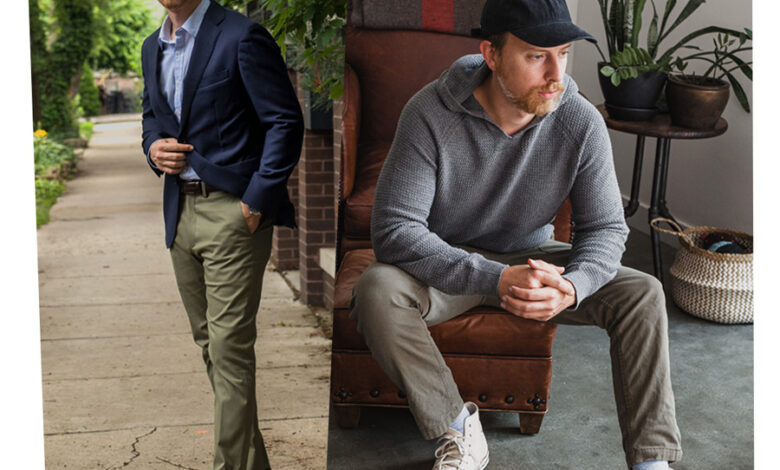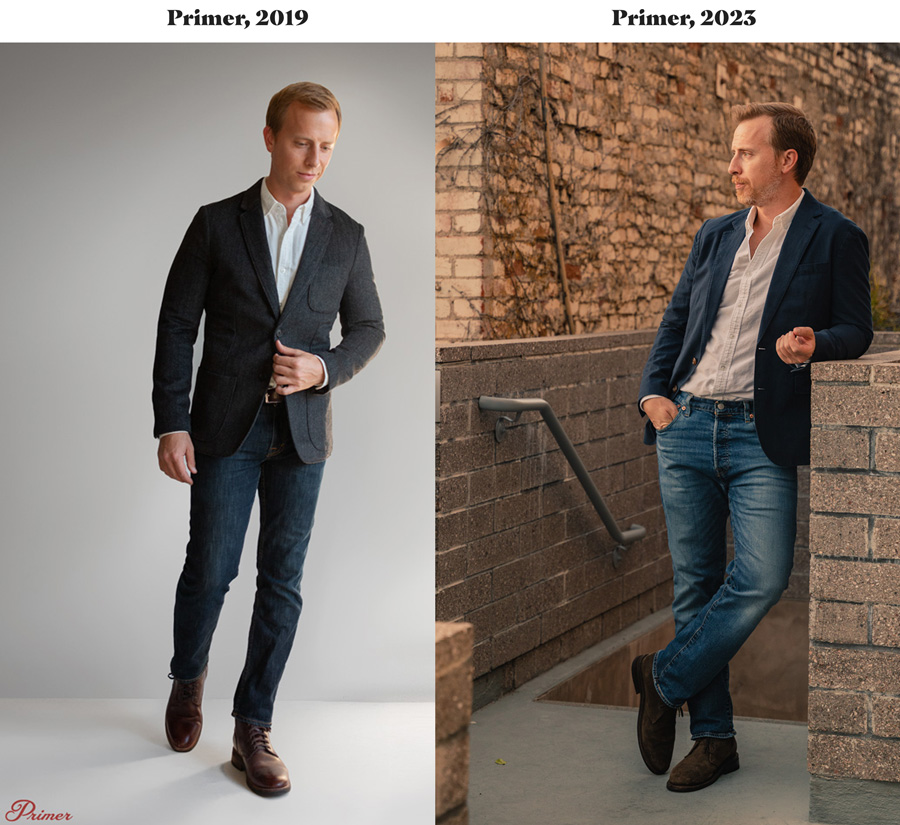Why Trends Still Matter Even If Dressing Better Doesn’t Mean Chasing Them · Primer

Dressing well is about more than clothes.
Dressing well is often misunderstood.
For the average guy—especially someone in his 30s or 40s, maybe married, with a practical mindset—style can feel like a balancing act. On one hand, there’s the pull to look sharper, feel more confident, and communicate something meaningful through your wardrobe.
On the other, there’s the constant noise of trends: slim fits are out, cargo pants are in, looser and chunkier styles from the ’90s and early 2000s are circling back.
It’s easy to feel overwhelmed or dismiss trends altogether as superficial fluff.
But ignoring trends entirely isn’t the answer either.
Clothing is inherently about communication, and trends are tools we use to connect with the world. The real challenge isn’t choosing between dressing how you always have and feeling forced to change—it’s about knowing what’s changing so you can make deliberate, strategic evolutions to your own style.
Sometimes that’s as small as swapping a belt, adjusting your pant fit, or integrating a new color, while the rest of your outfit stays exactly the same. The key is to stay informed, not because you have to follow trends, but so you can decide what works for you in a way that feels intentional rather than reactive.
Dressing Better Starts With You… but It’s Never Just About You
What you wear reflects your personality, values, and priorities. Your favorite leather jacket or perfectly worn-in jeans? They tell a story about who you are. A black leather jacket might signal confidence, a love for rugged classics, or even a nod to a rebellious streak you’ve had since your teens. Meanwhile, those jeans, worn soft from years of wear, could represent practicality, familiarity, and a sense of comfort in your own skin.
But here’s the catch: clothing doesn’t just stop at reflecting your internal world. It’s also a mirror turned outward, broadcasting messages about how you see yourself and your place in the broader social landscape. The way you dress shapes first impressions, communicates respect for the context you’re in, and sets the tone for interactions.
For an obvious example, walking into a business meeting in a blazer and dress shoes says you take the situation seriously, but arriving in sneakers and a hoodie might unintentionally signal a lack of preparation or regard for the event.

But—wearing that same outfit to a meeting at a creative agency or tech company, however, could have the opposite effect, signaling that you’re approachable, adaptable, and in tune with the informal, innovative culture of those industries.
This balance is what we call “social fluency”—the ability to read the room and dress in a way that communicates respect, cultural awareness, and connection while staying authentic to yourself.
Social fluency is something we instinctively understand in other areas of life. If a plumber quotes you a price that feels a little high and pulls up in a luxury truck, you might feel justified in questioning the cost. If he arrives in a truck that looks like it barely made the trip, you might feel like it’s overpriced and worry about the quality of his work. In both cases, you’re making assumptions based on non-verbal clues.
We do the same thing with people’s clothing. If you meet a financial advisor who is young and dressed too casually, you might doubt his experience. If he’s young but well-dressed, you might assume he’s exceptionally skilled for his age.
Our clothing serves as a form of social fluency by non-verbally communicating things like professionalism, competence, and cultural awareness.
This is why we stress about what to wear on a first date or when meeting a new romantic partner’s parents. Yet, many men take the stance that they don’t care what people think or that their actions should speak louder than their clothes.
While that might sound reasonable in theory, it ignores the reality of our lived experience. Every day since childhood, we’ve all made and encountered snap judgments based on appearance.
Trends factor into social fluency by signaling group alignment and positioning within that group.
These signals aren’t always fully within our control, but our clothing allows us to influence the assumptions people make about us.
To completely cast off trends robs you of the ability to manage this communication. Worse, even if you intentionally reject them, people will still make assumptions—you’ll just have no control over what those assumptions are.

For example, if you discovered your personal style in the mid-2010s and locked it in, that might have worked well then. But as visual culture evolves and pop culture shifts its focus away from our demographic, it’s easy to stay locked in place. Over time, this can make a guy look like he checked out in life in 2015 and is out of touch, in similar ways to the plumber and financial advisor examples.
We see extreme examples in older men who lived their best life in the ‘80s and still sport the same aggressive mullet. His hairstyle signals an increasing disconnect from the group he’s part of.
While this extreme version will probably not happen to you, more subtle, everyday examples play out constantly when men stop paying attention to change, whether they like it or not.
Social norms shift, reshaping fluency, authority, and identity—style mirrors this. We judge and are judged by these cues, whether we notice or not.
Ignoring trends entirely isn’t neutral—it signals disengagement, whether intentional or not.
How Trends Change and How You Can Evolve With Them

Once you get to a certain age, you will experience that feeling of not liking how things are changing. It’s natural. You like what you like.
But rather than writing off shifts in style as irrelevant or unnecessary, the smarter move is to simply understand them. That way, if you do decide to update anything, it’s because you’ve made an informed choice rather than stubbornly holding onto a past version of yourself that no longer fits the current moment.
Take the resurgence of ’90s and early 2000s aesthetics. When you first hear “baggy jeans and chunky sneakers,” you might think, been there, done that, don’t need to go back.
But here’s the thing: while silhouettes are changing, the core of what you like—whether that’s preppy, rugged, utilitarian, or something else—hasn’t. You’re not being asked to dress like your high school self. Instead, you have an opportunity to revisit ideas from that era with fresh eyes, applying them in a way that suits who you are now.
Below, compare two J.Crew catalog shots with a topcoat outfit from 2010 to a topcoat outfit from 2024. The coat itself hasn’t changed much, but the way it’s styled has adapted to modern proportions, fit preferences, and layering techniques:

Both outfits convey a refined yet casual sophistication, but they achieve this in different ways as trends have shifted. The older outfit incorporates a tie—once a staple, but now rarely seen in casual wear. Even more, the lighter-than-the-shirt tie feels especially dated. In contrast, the newer outfit drops the button-up entirely in favor of a V-neck sweater layered over a crew-neck tee—something we hadn’t seen much since the ‘90s, but that has come back around.
The biggest shift is in the pants. The 2010 look features slim, low jeans, while the 2024 version embraces fuller-cut, higher-rise trousers—reflecting the broader trend toward comfort and proportion play. If this were a real person rather than a model, he could have easily worn the same topcoat across both outfits, spanning 14 years of wear (and likely many more before and after).
Being mindful of trends and integrating updates isn’t in defiance of timeless (I prefer the term enduring) or “classic” style—it’s what keeps it feeling relevant. The coat stays stylish not because it’s “timeless” in isolation, but because of how it’s worn and what it’s paired with in the present moment.

For example, if you’ve always leaned toward classic, structured styles, maybe that means embracing a slightly looser cut in your trousers but keeping the same overall polished aesthetic. If you liked 2000s-era layering, you might swap in a relaxed chore coat over your usual button-up and chinos instead of suddenly switching to parachute pants and oversized tees.
A good analogy is the resurgence of mid-century modern design in interiors. When it came back into popularity over the last 15 years, we didn’t just copy-and-paste the ‘50s and ‘60s aesthetic exactly as it was. The updated version embraced the clean lines and timeless materials while refining the color palettes and softening some of the harsher, more rigid elements. Similarly, personal style can evolve by selectively incorporating modern updates without abandoning its foundation.

Small Changes Make a Big Difference
Trends don’t require a full wardrobe overhaul. More often, it’s about selective refinements:
Pants: If you’ve been wearing slim fit jeans for a decade, you don’t need to go full oversized, but a straight-leg or athletic cut might feel more current and comfortable.

Shoes: If your go-to was sleek, narrow dress shoes, try a chunkier loafer or a relaxed suede chukka boot for a modern touch.
Colors & Patterns: Earthy tones, rich browns, and deep greens are having a moment, but if you love your neutrals, incorporating just one piece in a new shade—like an olive sweater or a rust-colored overshirt—keeps things feeling fresh without pushing you outside your comfort zone.

Belts & Accessories: Swapping a thicker belt for a slightly narrower, more textured one can subtly shift the tone of an outfit without changing anything else.

The Bottom Line: Trends Are Clues, Not Rules
Understanding what’s happening in fashion isn’t about blind conformity—it’s about staying aware so you can make choices that align with who you are now. The strongest personal style isn’t frozen in time; it evolves thoughtfully. You’re not wearing trends because you feel pressured to—you’re making intentional decisions about what fits your life, your tastes, and your confidence.
You don’t have to love every trend. You don’t have to wear anything that doesn’t feel right. But knowing what’s happening gives you the power to decide, rather than having that decision made for you by default. And that’s real style.
https://www.primermagazine.com/wp-content/uploads/2025/02/why-trends-matter_1.jpg
2025-02-07 12:34:52





